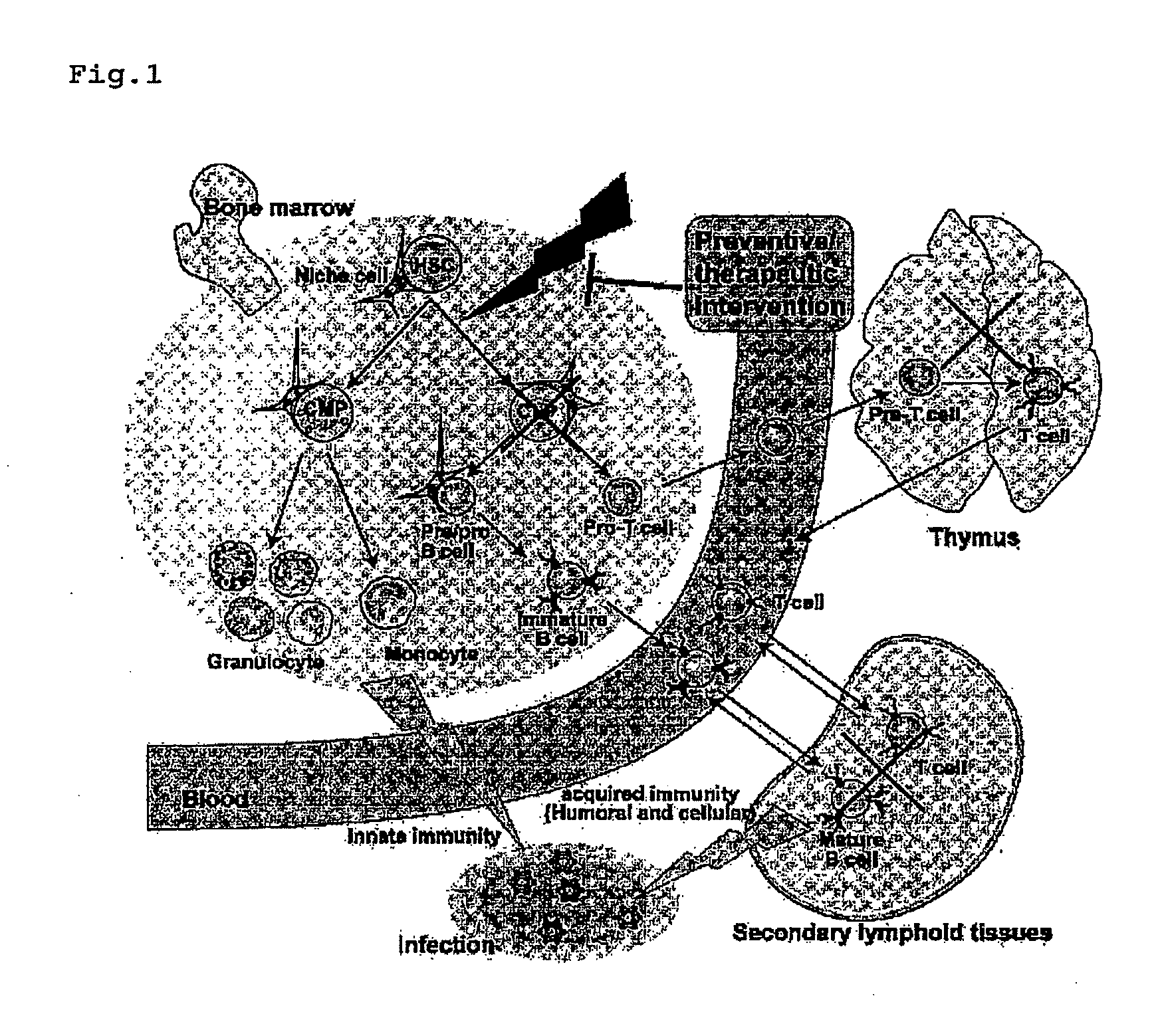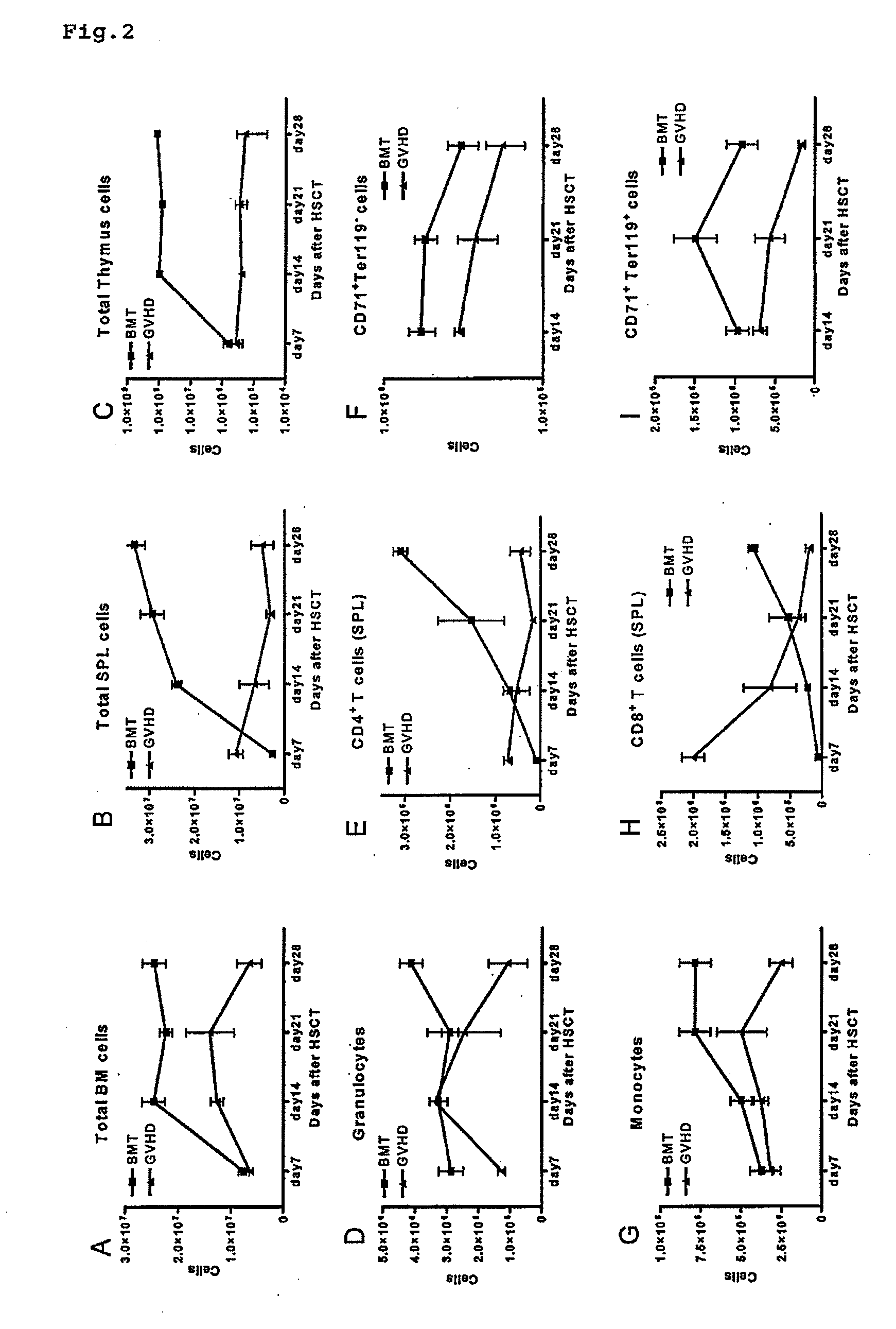Immunological reconstitution promoter or prophylactic agent for infections each of which maintains graft-versus-tumor effect
a technology of allogeneic hematopoietic stem cell and promoter, which is applied in the direction of antibacterial agents, immunological disorders, antibody medical ingredients, etc., can solve the problems of limited expansion of the use of this approach, no alternative treatment mechanism and effective treatment for delayed immune reconstitution after such transplantation have yet to be established, and no alternative treatment method
- Summary
- Abstract
- Description
- Claims
- Application Information
AI Technical Summary
Benefits of technology
Problems solved by technology
Method used
Image
Examples
example 1
Production of Animal Model of GVHD after Allogeneic Hematopoietic Stem Cell Transplantation
[0081]On the day prior to hematopoietic stem cell transplantation, the recipient mice (6-week-old female C57BL / 6xDBA2 F1 (BDF1, H2d / b)) were lethally irradiated (11 Gy) in two split doses given 3 hours apart. Some of the irradiated mice received both C57BL / 6 (B6, H2 / 3)-derived T cell-depleted bone marrow cells (5×106 cells) and splenic T-cells (5×106 cells negatively enriched against CD11b, B220, Ter119 and NK1.1). These mice are referred to below as the GVHD group. Others of the irradiated mice received only the C57BL / 6 (B6, H2b)-derived T cell-depleted bone marrow cells (5×106 cells). The latter are referred to below as the BMT group.
example 2
Flow Cytometric Analysis of Donor Hematopoietic Stem Cell-Derived Bone Marrow Hematopoiesis after Transplantation
[0082]Bone marrow, spleen and thymus were harvested from each animal in each group of mice prepared in Example 1, and the donor hematopoietic stem cell-derived bone marrow hematopoiesis from day 7 to day 28 following transplantation was analyzed over time by flow cytometry. Flow cytometry was carried out by a method known to persons of ordinary skill in the art.
[0083]FIGS. 2(A) to (I) show the change over time in the number of each of the following cells in BMT and GVHD groups: total bone marrow cells, total splenic cells and total thymic cells; and in the number of each of the following cells in bone marrow within the BMT and GVHD groups: granulocytes, monocytes, erythroblastic cells (CD71+ and Ter1194), and splenic CD4+ and CD8+ T cells. Decreases in the total number of bone marrow, splenic and thymic cells in the GVHD group, a recovery in splenic CD4+ T-cells in the BM...
example 3
Production of Animal Model of GVHD after Allogeneic Hematopoietic Stem Cell Transplantation (2)
[0084]On the day prior to hematopoietic stem cell transplantation, CD45.2+ recipient mice (6-week-old female C57BL / 6 XDBA2 F1 (BDF1, H2d / b)) were lethally irradiated (11 Gy) in two split doses given 3 hours apart. Some of the irradiated mice received both CD45.1+CD45.2+ congenic mouse-derived T cell-depleted bone marrow cells (5×106 cells) and CD45.1+ congenic mouse-derived splenic T-cells (5×106 cells negatively enriched against CD11b, B220, Ter119 and NK1.1). These mice are referred to below as the GVHD group. Others of the irradiated mice received only the CD45.1+CD45.2+ congenic mouse-derived T cell-depleted bone marrow cells (5×106 cells). The latter are referred to below as the BMT group.
PUM
| Property | Measurement | Unit |
|---|---|---|
| time | aaaaa | aaaaa |
| concentrations | aaaaa | aaaaa |
| body weight | aaaaa | aaaaa |
Abstract
Description
Claims
Application Information
 Login to View More
Login to View More - R&D
- Intellectual Property
- Life Sciences
- Materials
- Tech Scout
- Unparalleled Data Quality
- Higher Quality Content
- 60% Fewer Hallucinations
Browse by: Latest US Patents, China's latest patents, Technical Efficacy Thesaurus, Application Domain, Technology Topic, Popular Technical Reports.
© 2025 PatSnap. All rights reserved.Legal|Privacy policy|Modern Slavery Act Transparency Statement|Sitemap|About US| Contact US: help@patsnap.com



